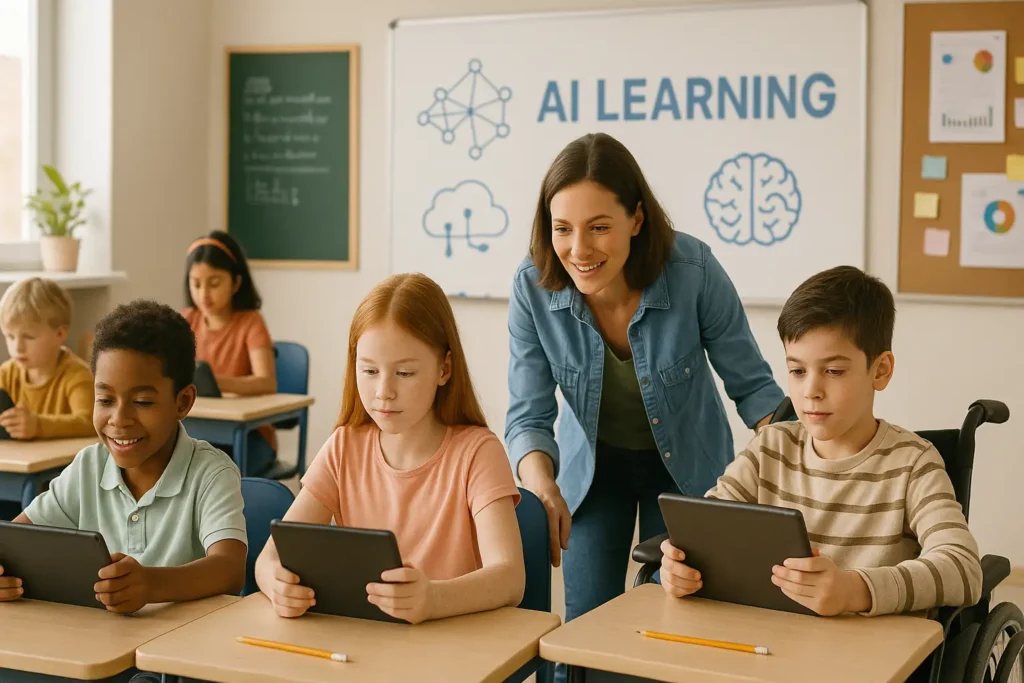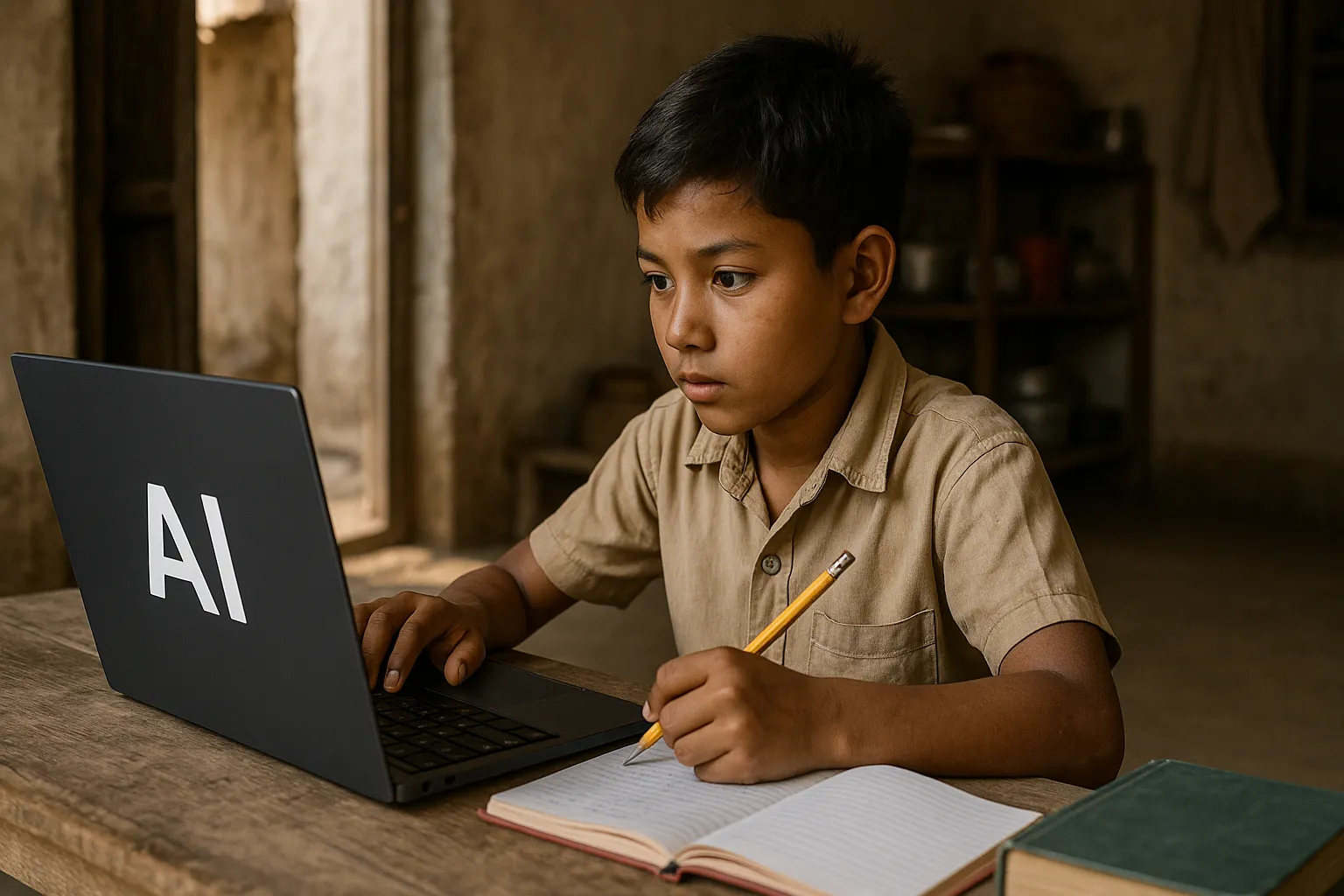Artificial Intelligence (AI) is no longer a thing of the future — it’s already here, and it’s changing the way we live, work, and especially, learn.
How AI Becomes a Tool for Inclusion and Equity
AI in education can be a powerful tool for inclusion and equity when used thoughtfully. Right from the start, it’s important to know that inclusion means making sure everyone, no matter their background, has a fair chance to learn. And equity is about giving each student what they need to succeed — not the same thing for everyone, but the right thing for each one.
Picture a classroom where every student has different needs. Some learn faster, others need more time. Some may have disabilities, or face language barriers. This is where AI steps in to help teachers reach every student in a personal and supportive way.
What Does Inclusion and Equity Look Like in Real Classrooms?
Let’s break it down with a few real-life examples that show how AI supports inclusion and equity:
- Personalized Learning: AI tools like Khan Academy’s AI Tutor adjust lessons to each student’s level. If one student struggles with reading, the AI provides simpler texts. If another student excels in math, it offers tougher problems to keep them engaged.
- Support for Students with Disabilities: AI-powered apps can turn speech into text for students who are deaf or hard of hearing. Tools like Microsoft’s Immersive Reader help students with dyslexia understand what they read more clearly by changing fonts, colors, and spacing.
- Language Inclusion: AI translation tools like Google Translate help students who are learning in a second language understand class content better. This allows immigrant or bilingual students to feel included and keep up with their classmates.
Why This Matters More Than Ever
Education should be a right, not a privilege. But many students face obstacles. They might not have enough money, live in isolated places, or come from communities where education wasn’t always a top priority.
AI doesn’t fix these problems overnight, but it helps level the playing field. For example:
- Students in rural areas can use AI-based online platforms to access quality lessons even if their schools lack resources.
- Children who missed school due to illness or family issues can catch up using AI tutoring systems.
Concerns and Challenges with AI in Inclusive Education
Although AI has amazing benefits, we also need to use it carefully and responsibly. Here are some things teachers and schools must watch out for:
- Data Privacy: AI collects lots of information about students. It’s important to protect that data and follow rules like LGPD (Lei Geral de Proteção de Dados) in Brazil, or GDPR in Europe.
- Bias in AI Systems: If the data used to train AI tools is biased, the tool might make unfair decisions. For example, if most of the training data came from wealthy communities, the AI may not understand the reality of students from different backgrounds.
- Access to Technology: Not every school or student has access to high-speed internet or modern devices. This can create a new type of inequality — the digital divide.
That’s why human oversight is essential. Teachers, not machines, should make the final decisions about what’s best for students.
👉 Should schools be concerned about AI in education? Learn how AI can help or hurt and how schools can prepare wisely.
How Teachers Can Use AI for Good
Teachers are the heart of education. AI should support them, not replace them. Here are ways AI can make teaching more inclusive:
1. Know Your Students Better
AI tools can show which students are struggling and with what topics. This helps teachers focus their support where it’s most needed.
2. Save Time on Routine Tasks
Grading quizzes, managing attendance, and organizing materials — AI can handle these tasks. This gives teachers more time to connect with students personally.
3. Create Accessible Materials
With AI, teachers can quickly translate content, add subtitles to videos, or generate different reading levels for the same text.

The Role of Families and Communities
Inclusion isn’t just about the classroom. Families, caregivers, and the entire school community have a role to play. When AI tools are introduced, it’s important that:
- Parents understand how they work.
- Schools offer guidance on safe and responsible use.
- Students are taught digital citizenship early on.
Technology should bring people together, not separate them.
The Future of AI in Inclusive Education
Looking ahead, AI is likely to become even more present in education. But its success depends on how we use it:
- With empathy, remembering that behind every data point is a human being.
- With fairness, making sure no one is left behind.
- With responsibility, ensuring that tools are inclusive, safe, and culturally aware.
AI is not a magic wand, but it can be a powerful tool for inclusion and equity when guided by caring teachers and informed communities.
Key Points About Tool for Inclusion and Equity
- AI helps adapt lessons to students’ individual needs.
- Tools like voice-to-text and translation apps promote inclusion.
- Teachers can use AI to identify learning gaps and support students.
- Bias and digital inequality are real challenges and must be addressed.
- AI should support, not replace, human decision-making in education.
- Inclusion also involves families and communities, not just schools.
Conclusion
AI is changing the face of education, and when used wisely, it can open doors for every student — especially those who often get left behind. It’s a tool that can bring more fairness, more access, and more hope to classrooms around the world.
But technology alone is not enough. What makes the difference is how we, as educators, families, and society, choose to use it. Let’s make sure AI works with us — and for everyone.
What do you think about using AI for inclusion in education? Share your thoughts in the comments!

